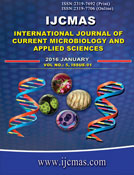


 National Academy of Agricultural Sciences (NAAS)
National Academy of Agricultural Sciences (NAAS)

|
PRINT ISSN : 2319-7692
Online ISSN : 2319-7706 Issues : 12 per year Publisher : Excellent Publishers Email : editorijcmas@gmail.com / submit@ijcmas.com Editor-in-chief: Dr.M.Prakash Index Copernicus ICV 2018: 95.39 NAAS RATING 2020: 5.38 |
Iraq in 4 decades ago was undergo several wars in particular that started from 1980 till to recent time has had potential effects on economic outcome, subsequently impact of public health of Iraqi peoples living in areas where the war was continuous. So, that the current study was conducted to estimate prevalence of Giardia lamblia and other intestinal Parasites among Iraqi displaced people (IDPs) using two different laboratory techniques. For this purpose, 417 stool samples from both gender and ages from below one year to 60 years were collected from peoples in 12 districts in Kirkuk Province, whom they live under poor hygienic condition and low level of sanitation. Two laboratory methods where performed on each collected stool sample; namely direct double wet preparation of 0.85% of NaCl solution and 1% Lugol s iodine and formalin-ether concentration method. The overall rate of intestinal parasitic infection was 19.66 %, this rate was divided in to 10.31 % for Giardia lamblia and 9.35 % for other 9 intestinal parasites. They involve: Blastocyst homonis 4.17 %, Entamoeba histolytica 1.67 %,Cryptosporidium parvum 1.43 %, Entamoeba coli 0.71 %, Cyclospora cayetanensis, 0.49 %, and 0.23 % for each of Entamoeba hartmani, Iodomoeba butschili, Hymenolepis nana and Ancylostoma duodenale. Statistically formalin- ether technique show high efficacy and significance than wet preparation technique in demonstrating other intestinal parasites. Also Giardia lamblia was highly found among peoples aging from 1 year to 10 years than in other age groups. While relationship between giardiasis and types of applied laboratory methods and patients gender was not significant. The rate of giardiasis among IDPs was high speciallyparticularly among young aged peoples. Formalin-ether concentration technique had value in detecting other intestinal parasites rather than detecting giardiasis.
 |
 |
 |
 |
 |